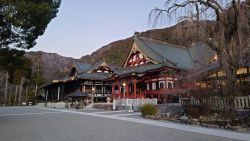
November 9, 2006
Sulawesi
Scenic beauty and explosive rituals go hand in hand in Indonesia
By Metropolis
Originally published on metropolis.co.jp on November 2006

Photos by Simon Rowe
The midnight assault on our hotel compound comes with no warning. Six rangy figures race through the darkness, each one hauling a long, tube-like canister across the boggy marsh, no more than 50 meters from the hotel garden.
A minute later an eardrum-bursting KAH-boom shakes the balcony, rattling the windows and sending me and other hotel guests ducking beneath our sweaty shirt collars.
A second and then a third muzzle flash lights up the swampy darkness. We tensely await the “shell bursts.”
Beirut? Baghdad? Bogotá? Nope. These are firework shenanigans, local-style, on the curiously shaped Indonesian island of Sulawesi, which lies halfway between Borneo and the Spice Islands. The “heavy artillery” are the playthings of giggling village teenagers, who call them barattung: large sections of hollowed-out giant bamboo into which drops of gasoline are poured and then ignited with a taper.
The resulting explosion of gas fumes sends nothing but a puff of white smoke into the air, but the inter-neighborhood barrages, which reach their peak during celebrations for the end of the rice harvest season in December, ensure restless nights for travelers.

While real-life bomb blasts and sporadic sectarian violence between Muslims and Christians since 2000 have been anything but a cause to celebrate for Indonesia’s tourism industry, provincial administrators are reporting a cautious comeback by foreign travelers to central Sulawesi and popular spots like the Togean Island marine tourist resort.
Tana Toraja, a highland province with a particularly distinctive heritage, remains an old favorite for those brave enough to endure the five-hour bus trip from the port city of Ujung Pandang in south Sulawesi. Here, high in mist-shrouded valleys, the predominantly Christian province appears blissfully cut off from conflict, while the rattle-and-hum of Indonesia’s rapidly modernizing archipelago seems a world away.
Torajan people still practice aluk to dolo, or “ways of the ancestors,” in the form of funeral rituals and animal sacrifices, many timed to coincide with the end of the rice harvest. Travel agencies from Tana Toraja’s hub town of Rantepao have never been slow to cash in on these events, providing tourists with dates, times, buses, pack lunches and multilingual guides, all at the flash of hard currency.
Today is no exception. Dazed and sleepless from the nighttime bombardment, I pay the going price—the equivalent of ¥1,200—and tag along on a three-person tour. We make our way to the tiny mountain hamlet of Balusu, where more than 1,000 guests are gathered to send off their deceased chief. Bunches of betel nut jiggle on the morning breezes while photos of the dead man swing from the eaves of the village’s boat-like tongkonan rice barns.

The atmosphere is more festival than funeral as guests mingle and chat among hundreds of “gift” buffaloes assembled for the ceremony. These offerings, explains one man, are required to send the deceased to heaven, where the success of his past life will be determined by the number of animals he takes with him.
No one, however, is quite prepared for what happens next. The field transforms into a corral for more than 100 buffalo and their handlers, mostly elderly farmers who stroke their beasts of burden with loving yet somber faces. Only they know that one of them is about to die.
I hear the spine-tingling sizzle of a small knife being sharpened on a steel behind me and turn to find a man with sinewy arms honing his kris, or farm knife, to a razor-sharp edge. A final puff on his fragrant kretek cigarette, and he moves with a purpose through the crowd to where the first of 100 buffalo stands, oblivious to its fate.
Crouching bodies bolt upright and visibly stiffen; some back off to a safe distance. The little man with the knife knows what they are thinking: if the throat is not cleanly cut, the buffalo will panic and rampage into the crowd, and two funerals in one day would not look good.

With one hand resting gently on the beast’s head, the other makes a deft swiping movement so fast that if you were to blink you would miss it. The huge animal lumbers to the ground. In keeping with Torajan tradition, the slaughter is quick and precise and no part of the animal is wasted—horns and hides are cleaned and stretched to dry in the sun, while the meat and offal are immediately distributed among guests.
Rain begins to fall, and hundreds of swiftlets suddenly fill the late afternoon sky. Across the valley, a fine white cloud rolls down the slopes of Mt. Tomonga and onto the river plains, where music and laughter are background noise to the rhythmic slash of farmers ’ kris across rice stems.
It’s hard to believe there has been a death in paradise today.
Garuda Airlines flies from Jakarta, Denpasar (Bali), Kuala Lumpur and Singapore to Sulawesi Makasar Airport, 25km from Ujung Pandang. See www.garuda-indonesia.com for schedule info. Long-distance buses run daily from Ujung Pandang and stop at Tana Toraja’s largest town, Rantepao. The best time to visit is April to November, when days are warm and nights cool. The end of the rice harvest season in December is also a lively time. Rantepao’s tourist office advises on local festivals and funeral ceremonies. Sign up for a tour through them, or at one of the guesthouses and restaurants that offer guide services. For the mother lode of hotel, guesthouse, even homestay, options in Rantepao, check out Rough Guides Indonesia online edition (www.travel.roughguides.com).







